Impact of external pressure and nanoparticles on heat transfer in couple stress Oldroyd-B fluid: A numerical study
IF 4.4
2区 物理与天体物理
Q2 MATERIALS SCIENCE, MULTIDISCIPLINARY
引用次数: 0
Abstract
This study investigates the flow characteristics of an Oldroyd-B Couple Stress Fluid (OBCSF) under external pressure within the framework of the Buongiorno model. Understanding this dynamic behavior is crucial for advancements in nanofluid technology and non-Newtonian fluid mechanics. The complex behavior of non-Newtonian fluids arises from internal microstructural effects, which are well described by the Oldroyd-B model. The additional influence of external pressure and nanoparticle effects further complicates the flow dynamics, necessitating a comprehensive numerical analysis to understand their combined impact. The governing equations for continuity, momentum, heat transfer, and concentration are formulated and solved numerically under appropriate boundary conditions for the coupled Oldroyd-B fluid and Buongiorno model. A numerical approach integrating the finite difference and finite element methods is employed to analyze the system under varying external pressure conditions and different nanoparticle volume fractions. The numerical simulations reveal significant variations in velocity profiles, temperature distribution, and concentration due to changes in external pressure. The presence of nanoparticles alters viscosity and thermal conductivity, thereby influencing heat transfer within the fluid. Furthermore, the couple stress parameter introduces additional complexity, exhibiting shear-thinning or shear-thickening behavior depending on its magnitude, which in turn affects the overall flow characteristics. These findings underscore the intricate interplay between external pressure, nanoparticle dynamics, and the non-Newtonian properties of the fluid. The study has practical implications for optimizing heat transfer processes in nanofluid-based systems and enhancing the efficiency of industrial applications involving complex fluid dynamics. The insights gained from this research contribute to the design and improvement of technologies that rely on nanofluid mechanics and the distinctive properties of non-Newtonian fluids.
求助全文
约1分钟内获得全文
求助全文
来源期刊

Results in Physics
MATERIALS SCIENCE, MULTIDISCIPLINARYPHYSIC-PHYSICS, MULTIDISCIPLINARY
CiteScore
8.70
自引率
9.40%
发文量
754
审稿时长
50 days
期刊介绍:
Results in Physics is an open access journal offering authors the opportunity to publish in all fundamental and interdisciplinary areas of physics, materials science, and applied physics. Papers of a theoretical, computational, and experimental nature are all welcome. Results in Physics accepts papers that are scientifically sound, technically correct and provide valuable new knowledge to the physics community. Topics such as three-dimensional flow and magnetohydrodynamics are not within the scope of Results in Physics.
Results in Physics welcomes three types of papers:
1. Full research papers
2. Microarticles: very short papers, no longer than two pages. They may consist of a single, but well-described piece of information, such as:
- Data and/or a plot plus a description
- Description of a new method or instrumentation
- Negative results
- Concept or design study
3. Letters to the Editor: Letters discussing a recent article published in Results in Physics are welcome. These are objective, constructive, or educational critiques of papers published in Results in Physics. Accepted letters will be sent to the author of the original paper for a response. Each letter and response is published together. Letters should be received within 8 weeks of the article''s publication. They should not exceed 750 words of text and 10 references.
 求助内容:
求助内容: 应助结果提醒方式:
应助结果提醒方式:


